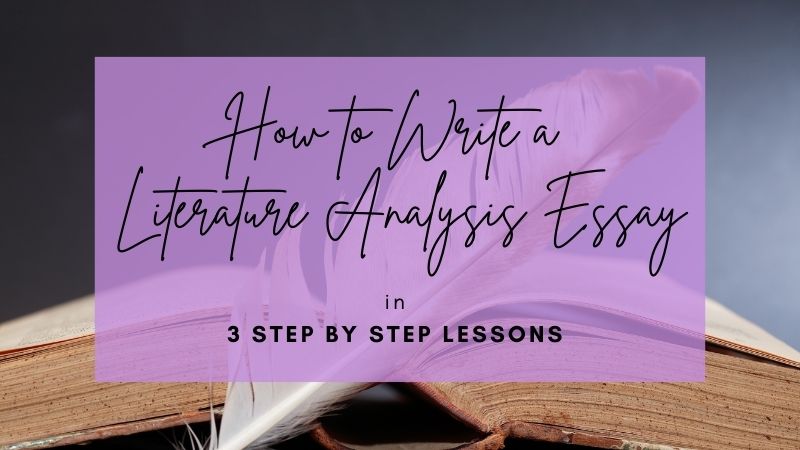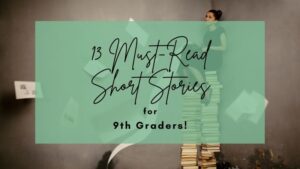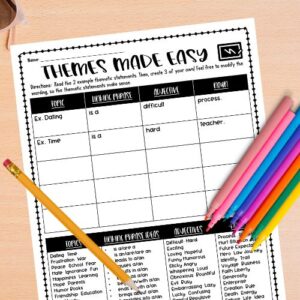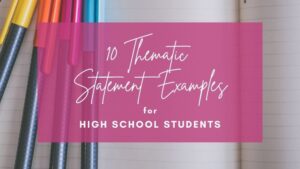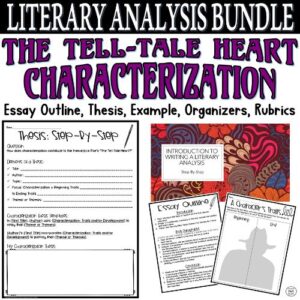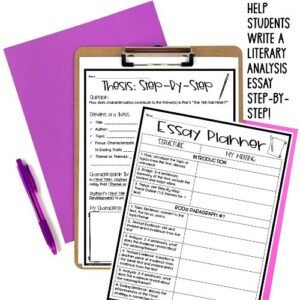As an adult when you pick up a book, you are rarely thinking, “I would LOVE to write a Literature Analysis Essay!” I think our students have the same mindset. At the end of every book comes a dreaded assignment, not just the satisfaction of having finished and actually enjoyed a book.
Most middle and high school students struggle with text frustration because it takes a lot of energy to think beyond merely comprehending the plot, characters, and major ideas within a text. It takes higher-level skills to break down the meaning and see more than what is written on the surface level.
So let’s make it easier for our students by teaching them how to write this type of essay!
Below are simple and easy lessons you can follow to make teaching the Literature Analysis Essay just a bit easier for you and your students!
Need help with Test Prep? Check out this FREE Pack of 3 Test Prep Activities to help students achieve success on standardized tests!

How to Write a Literature Analysis Essay
1. Give students a Focus on Characterization: Day 1/2
When I was in college, literary analysis was usually guided in some way by my college professors. They taught. We listened. They gave us a focus in terms of what they expected. Then, we applied this knowledge.
We have to do the same for our students.
If you want your students to be successful on this type of essay, they will need a step-by-step process. AND this process needs to begin as soon as your students begin reading a text.
You can really provide ANY fictional text for analysis:
- Poetry
- Plays
- Novels
- Short Stories
- Songs
- Reading Excerpts
In fact, you might want to start with a short story. Students usually love short stories. After all, they are pretty short.
Let’s say your students are reading “The Pedestrian” by Ray Bradbury. Before your students begin reading, provide activities based on the type of literature analysis essay you want them to write.

Maybe you want them to focus on how characterization leads to the theme. You could follow this lesson for introducing and teaching characterization:
- Bell Ringer: In a journal response, answer the following questions: Who is someone you admire? What 3 traits does this person have that you admire? Your response should include at least 3 sentences.
- Mini-Lesson: Teach about internal and external character traits. Students can connect to the bell-ringer through this activity! Then, explain to your students that you will be focusing on character traits as you read “The Pedestrian” by Ray Bradbury.
- Teacher Modeling (I Do): Read the first several paragraphs from the story. Use a graphic organizer to compare/contrast Leonard and the neighbors. Provide an example of evidence and a trait based on Leonard. Trust me. This process will help so much when preparing for the literature analysis essay.
- Teacher and Students Collaboration (We Do): Read a little more or focus on the first few paragraphs. Let students help by providing a piece of evidence and a trait based on the neighbors.
- Independent Work (You Do): Give students time to finish reading independently, listening to the rest of the story in an audio version, or reading aloud. Of course, this process all depends on your students’ needs. Then, provide time to finish the organizer with at least 2 more pieces of evidence/traits for each: Leonard and the neighbors. By the end, students will have 6 pieces of evidence and 6 traits to write about to prepare for their essays.
Want more ideas for teaching short stories? Check out 13 Must-Read Short Stories for 9th Graders!
2. Teach how to write a Thematic Statement: Day 3/4
Most students can usually understand WHAT is going on in a story. They might even be able to identify the overall topic/subject in one or two words.
Unfortunately, many do not understand how to write a theme. When writing a literature analysis essay, knowing how to determine the theme is vital. A theme is the overall message/lesson of the story. Now, there is no perfectly written theme provided, so students need to be able to create a 1-sentence theme for a literature analysis essay.
- Bell Ringer: In 1 paragraph, answer the question. Do you agree or disagree with the following statement? “Technology makes the world better.” Provide a piece of evidence to support your ideas. Your response should include at least 3 sentences.
- Mini-Lesson: Use this Themes Made Easy activity to teach this lesson. In this organizer, students are given topics, linking phrases, adjectives, and nouns to make writing themes simple and easy. Here are some examples: 1) Dating is a difficult process. 2) Time is a hard teacher.
- Teacher Modeling (I Do): Show a short film or clip appropriate for your class. There are many that can be related to technology. Model how to write a thematic statement based on the short clip.
- Teacher and Students Collaboration (We Do): Let students work together in pairs or small groups to come up with a thematic statement based on the film clip.
- Independent Work (You Do): Now, take students back to the text or texts they read previously. Using the characterization organizer they filled out, students can then create a thematic statement based on their information. Include guided questions: Through the use of characterization, how does the author develop the theme? What themes could be true based on the passage?
Click below for more help with teaching thematic statements that will help as students prepare to write a literature analysis essay!
3. Write a 4 Paragraph Literature Analysis Essay: Days 5-8
After the above activities, students should have everything they need to be successful on a very basic literature analysis essay. The goal is to guide our students in writing an essay that examines how characterization leads to the theme of the text.
- Bell Ringer: Show students the writing prompt. Then, students can write down what they might need to be successful in writing a response, what questions they have, what concerns they might experience, etc.
- Mini-Lesson: ***Make sure students have their characterization and theme information. Introduce the literature analysis essay outline. I prefer including an outline with sentence-by-sentence writing tips, so students have an outline they can use throughout the writing process.
- Teacher Modeling (I Do): Model how to write an introduction using another text you have read during the year. If students have a teacher example, the process will be much easier. Here is an example thematic statement: In “The Tell-Tale Heart,” Edgar Allan Poe uses progressively extreme characterization to describe a person with a crazed nature bent on killing who gradually becomes completely insane to relay that people are capable of immense evil but may also become convicted by guilt if they do something wrong.
If you keep the introduction to 4-6 sentences, students should be done within 30 minutes. Keep the introduction on the board. You may need more or less time, and that is totally okay. The rest of the time on days 5-8 will be used to write the rest of the essay. - Teacher and Students Collaboration (We Do): Using the characterization and theme activities, model how to use the evidence, traits, and links to the theme to write a body paragraph. Students should be able to use what they have already created to write this essay. If you model this process and let students help based on a previously read text, it will give them a map for future writing.
- Independent Work (You Do): Give students about 60-90 minutes to write the rest of the essay in class. Some students may want to take the assignment home, but with all of the AI issues going on nowadays, I would encourage you to have them turn in what they have. Think about it. They already have the theme written, evidence to use, an analysis of the character traits, an outline, etc. For a conclusion, use a 3-4 sentence paragraph structure: 1) Reinforce the Theme or Themes: discuss the ultimate purpose of the text in conveying a theme or themes. 2) Effectiveness: highlight what makes the focus element effective or vital to understanding the meaning of the text. 3) Reflection: end on an idea that connects to a greater, more universal concept/belief as to why the text and its messages are important. If you have a rubric, it will make the process of assessment for a literature analysis essay that much easier.
Click below to get this Literary Analysis Bundle to help your students through the process of writing a literature analysis essay for “The Tell-Tale Heart” or ANY text!
By starting out in this step-by-step manner, your students may not produce perfection, but they will be more successful than a student who is given a question and told to write a Literature Analysis Essay. I think most of us can relate to this situation as I had many college professors do just this. And it was a bit scary.
Let’s take the fear out of writing a literature analysis essay!
Want more ideas for Literature Analysis Essay Ideas? Check out my store Kristin Menke-Integrated ELA Test Prep!

